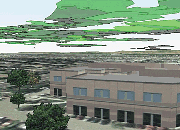
« PREVIOUS ENTRY
And apparently the moon has a chocolate-nougat core, too
NEXT ENTRY »
I can name that font in six notes

You’ve probably heard about the controversies over RFID tags, which report the location and identity of whatever device they’re attached to. You may have heard of the scientists who recently developed a tiny tracking chip to implant in a patient’s skin. And you may even have heard of “location-based services” — mobile phones that know where they are and can, say, recommend the nearest Italian restaurant.
Now here’s a new buzzword: “Reality mining”. It was coined recently by the futurists at Accenture, and it stands for the type of data-surfing we’ll be able to do when everything around us — our phones, our cars, our pants, our dogs, and everything else that is and isn’t glued down — has the ability to report on its location and its current state.
Think of “reality mining” as a supercharged version of the presence-management abilities of the AOL Buddy List. The Buddy List gives you one or two simple bits of information about your posse: Who’s online? And if they’ve been dormant, how long? This lets you get a nigh-tactile sense of the current status of your friends, almost as if you were able to glance around the room and look at everyone. Now imagine your buddy list were able to track all sorts of other things: Where your spouse’s car currently is (and how fast it’s travelling), where your kids are (and who they’re with), how busy each of the local restaurants are, and which bank machine near you has the biggest lineup. It’s sort of like having ESP. The Accenture guys also call this “Reality Browsing”, which is maybe a better metaphor, and they give the following scenario:
Before they leave home, shoppers could check for local traffic conditions, parking availability, and size of checkout lines and shopping crowds. As additional sensors and Web services become available, we envision scenarios in which users can check if rental movies, dry cleaning, or theater seats are available before leaving the house.
The commercial-style applications are obvious enough. But what intrigues me are the non-commercial ones — tracking the social dynamics of our friends, being able to see and rewind data about our neighborhoods. It’s about visualizing the world in a really new way, and the thing is, this isn’t really all that far off in the future.
As a very simple demonstration of reality mining, the Accenture guys made a 3D map of their California business-park neighborhood, where the current stock-market value of each company is represented by a shade of green hanging in the sky over their building (pictured above). As you fly through the 3D world, you can see the information made physical, sort of like health-bars in video games, floating over combatants to track how they’re doing. Indeed, video games are the past masters at displaying reality-mining-style info, so I wouldn’t be surprised if our everyday info-interfaces in the future start to look more and more like Grand Theft Auto.
(Thanks to Mindjack for this one!)
I'm Clive Thompson, the author of Smarter Than You Think: How Technology is Changing Our Minds for the Better (Penguin Press). You can order the book now at Amazon, Barnes and Noble, Powells, Indiebound, or through your local bookstore! I'm also a contributing writer for the New York Times Magazine and a columnist for Wired magazine. Email is here or ping me via the antiquated form of AOL IM (pomeranian99).

ECHO
Erik Weissengruber
Vespaboy
Terri Senft
Tom Igoe
El Rey Del Art
Morgan Noel
Maura Johnston
Cori Eckert
Heather Gold
Andrew Hearst
Chris Allbritton
Bret Dawson
Michele Tepper
Sharyn November
Gail Jaitin
Barnaby Marshall
Frankly, I'd Rather Not
The Shifted Librarian
Ryan Bigge
Nick Denton
Howard Sherman's Nuggets
Serial Deviant
Ellen McDermott
Jeff Liu
Marc Kelsey
Chris Shieh
Iron Monkey
Diversions
Rob Toole
Donut Rock City
Ross Judson
Idle Words
J-Walk Blog
The Antic Muse
Tribblescape
Little Things
Jeff Heer
Abstract Dynamics
Snark Market
Plastic Bag
Sensory Impact
Incoming Signals
MemeFirst
MemoryCard
Majikthise
Ludonauts
Boing Boing
Slashdot
Atrios
Smart Mobs
Plastic
Ludology.org
The Feature
Gizmodo
game girl
Mindjack
Techdirt Wireless News
Corante Gaming blog
Corante Social Software blog
ECHO
SciTech Daily
Arts and Letters Daily
Textually.org
BlogPulse
Robots.net
Alan Reiter's Wireless Data Weblog
Brad DeLong
Viral Marketing Blog
Gameblogs
Slashdot Games